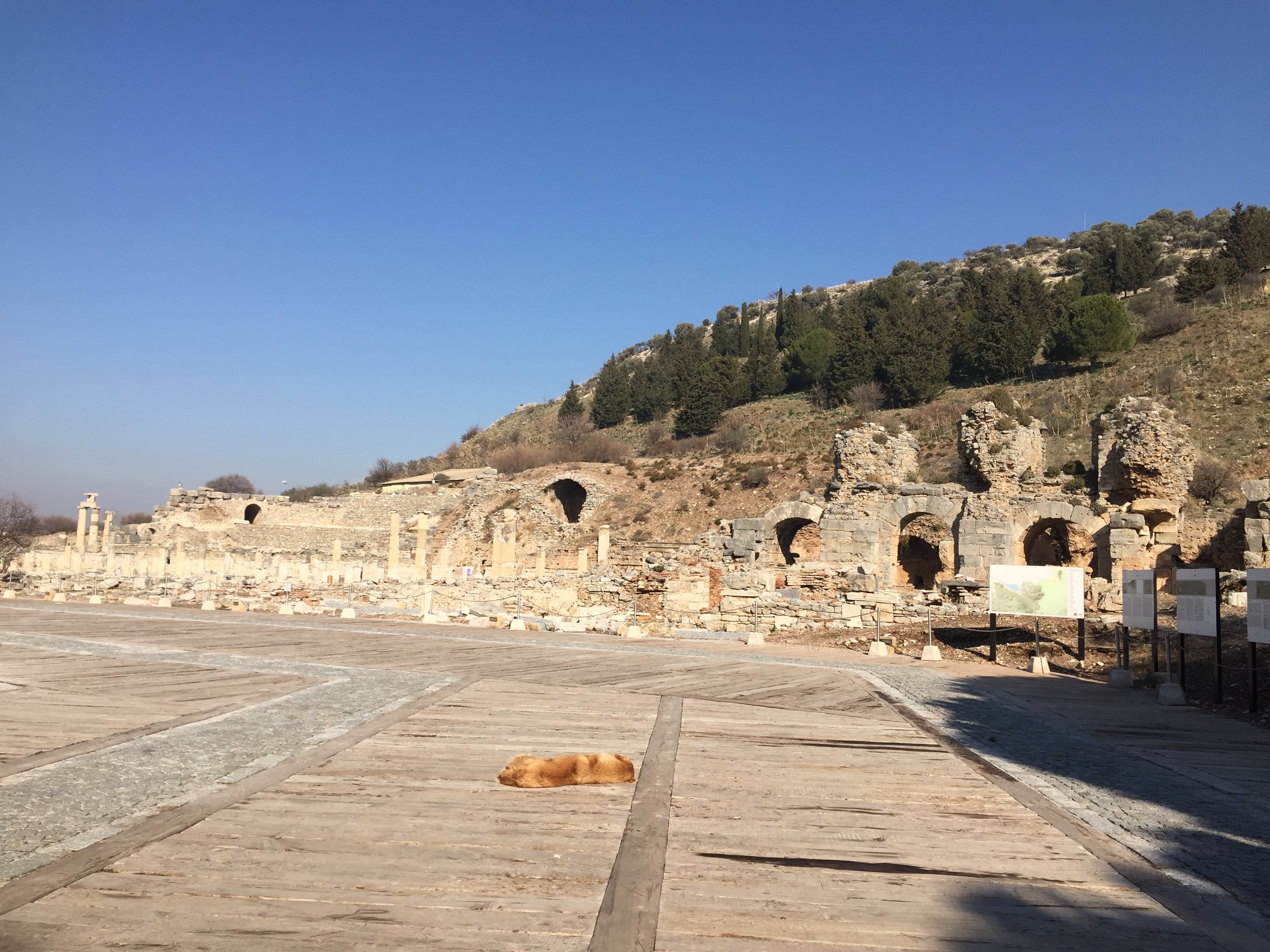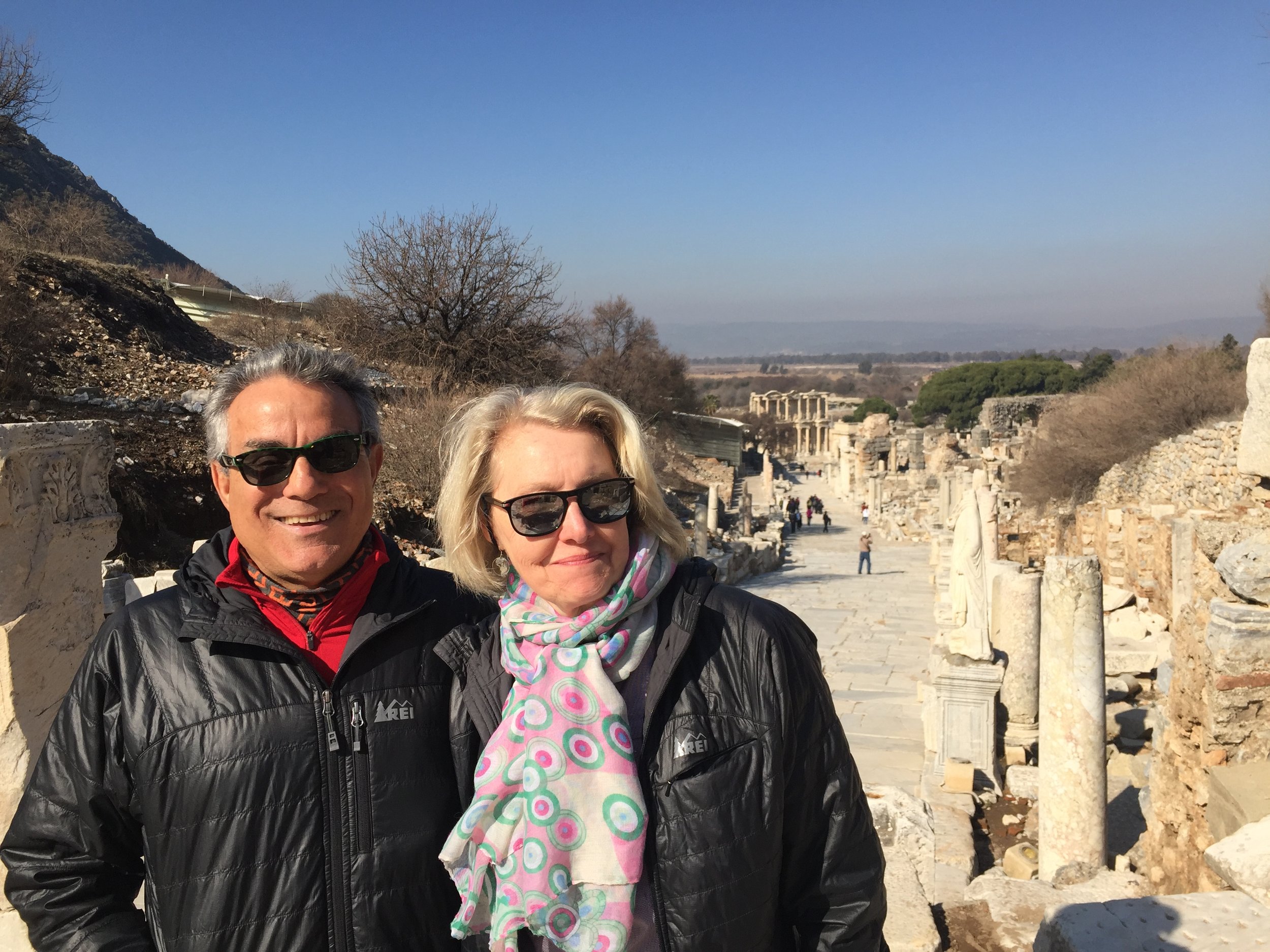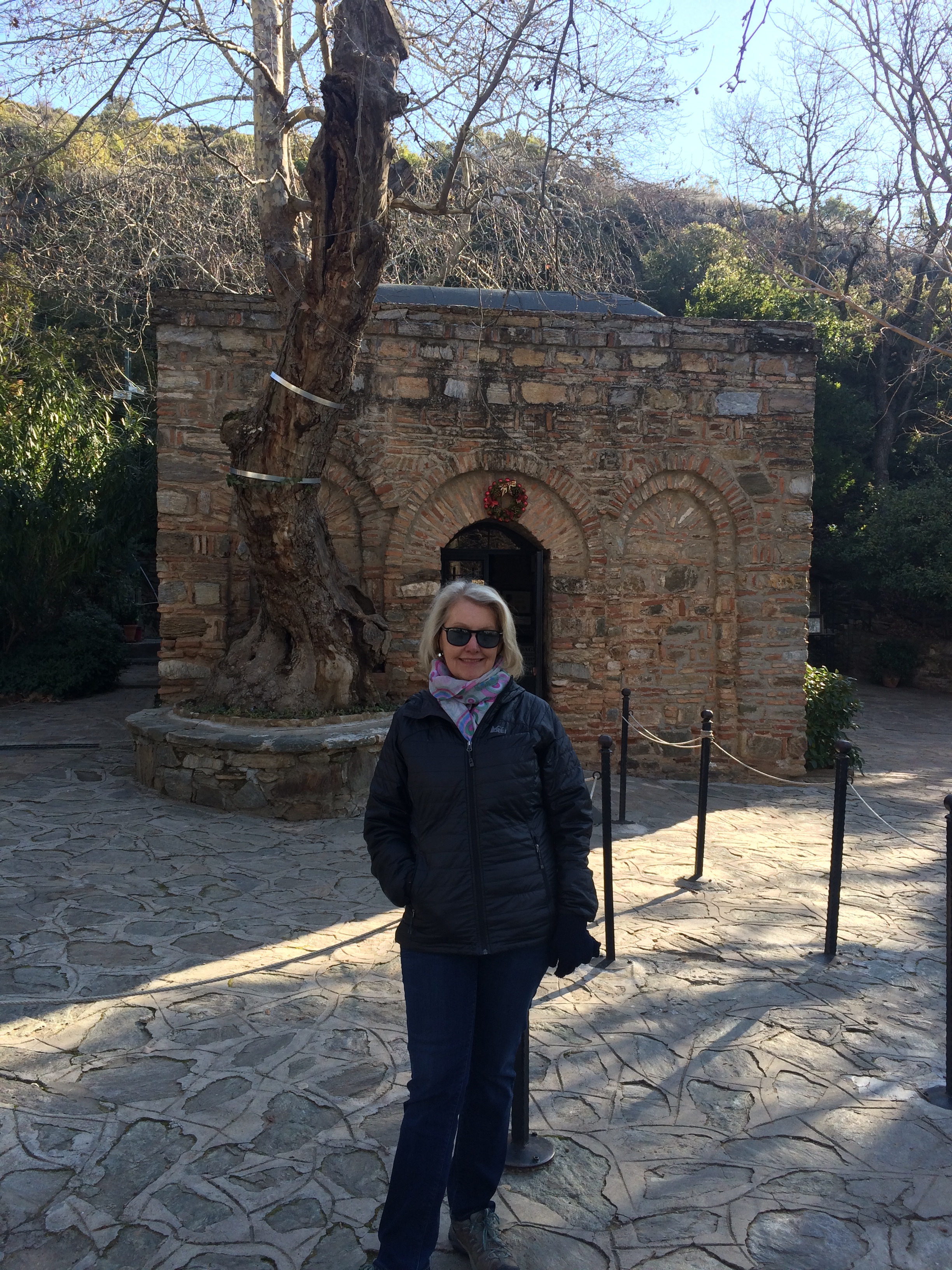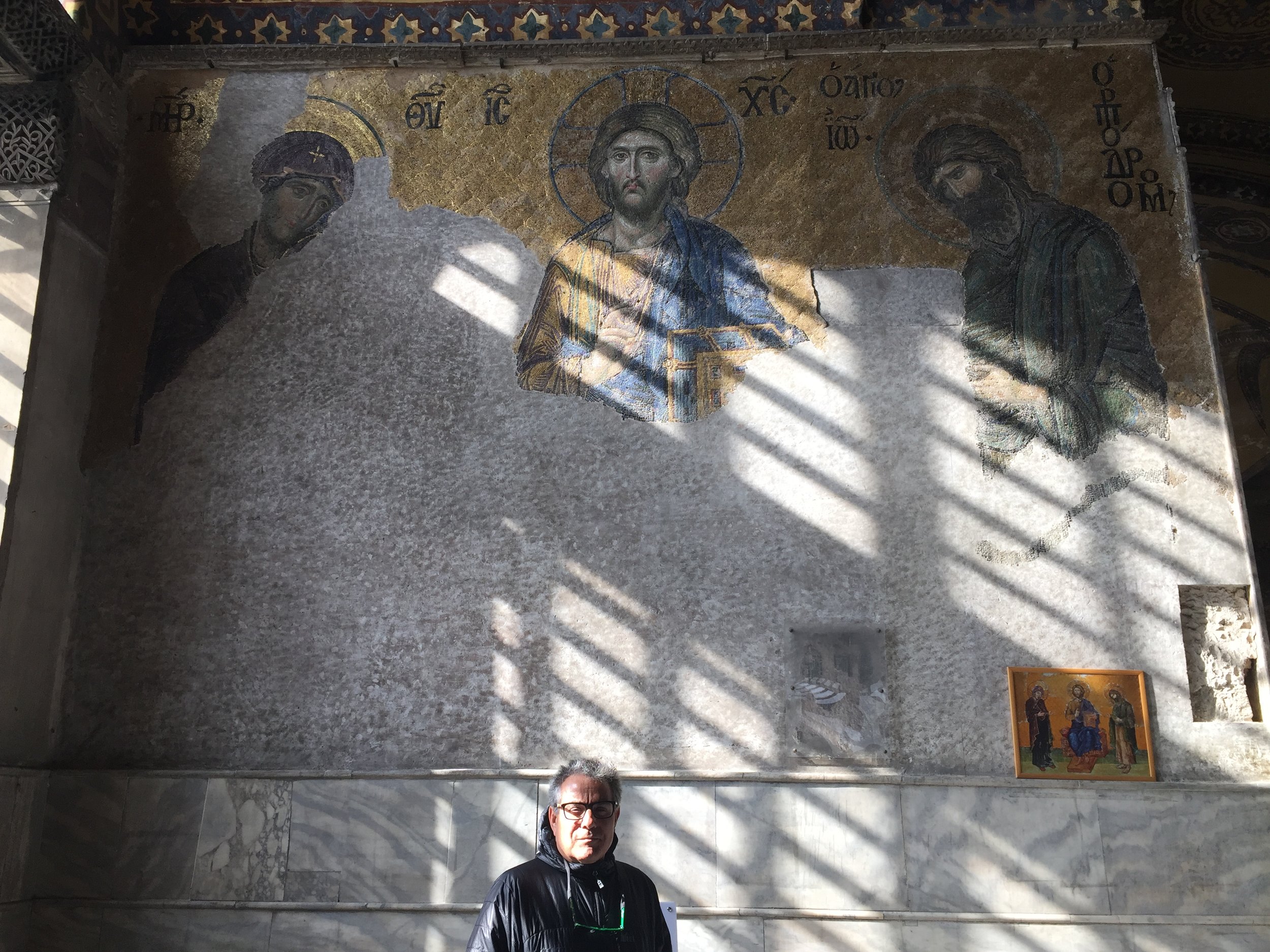Istanbul
We traveled from the Cairo airport for our Turkey flight in a transport van with half of our group. We have some trepidation, traveling the day after Trump announced a ban on Islamic people into the US. This is a challenging time to visit Islamic countries.
The airport was extremely busy due to extra security. In Cairo you now enter the first screening as soon as you enter the airport; shoes off, electronics out, belts off, and pockets empty. This was a long wait but professional. The second screening was at the gate and was very thorough, it included a full body pat down and they questioned Frank inhaler and the the portable speaker. It was also interesting to have the females in a separate line where Janet was told to wait for the female officer. She also went through pat down.
In Istanbul, like Cairo, due to the political climate we chose to stay in a new fancy Hilton and opted for a full paid tour of the city rather than our normal free walking tour.
Our tour guide, Emre Onal, picked us up and we traveled to the historic district. He is a very learned guide and a husky man that makes you immediately feel safe. Our first impressions of Istanbul are very positive. It looks more like a European city than like the Islamic cities we have seen before. It appears very modern and clean, without overly bad traffic. Our guide pointed out where the New Year’s Eve bombing occurred; in a fashionable area at the foot of the bridge spanning a narrow part of the Bosporus Straights. This was the beginning of several discussions about the effect terrorism was having on the tourism business; same as in Egypt.
The guide, throughout the day pointed to all popular sites on how empty they were, he said at big sites, there should be 1,000 people here, and lines. For us there was just a few people and no lines. Sad for him; good for us, maybe. We ask if he had any American tourist since New Year and he told us no, and we think he had not many clients from anywhere yet this year.
The historic district is very walkable. We started at the and moved to the Hagia Sophia (closed for day) to the Blue Mosque without any delay.
The “Blue Mosque” It has a Byzantine like dome and 6 minuets. In ancient times this caused a problem for a while, because the Mosque of Mohammed in Mecca, Saudi Arabia, also had 6 minuets and to be equal was seen as disrespectful. The sultan of Istanbul, Ahmed Sultana, sent the supplies and workers and money to build 4 more minutes at Mecca. Problem solved without bloodshed, just money.
We are allowed to enter, without shoes and Janet's head covered, and take in the mosaic of blue porcelain tiles that cover the entire gigantic structure. Some 3000 can pray inside, and on Ramadan an additional 10,000 can pray in the court yard, with another 10,000 attending on closed streets. Beautiful and impressive , but not as big as the newer Hasan ll mosque in Casablanca, Morocco.
Typical Dessert of figs, ice cream and oranges
We had a wonderful lunch in a small café where the hosts were very open to discussions about Turkish politics, as was our guide. They recognize the difficulty that Turkey has by being a progressive country interacting with Europe, maybe joining the EU, and then adjoining the Arabic countries of the Middle East. They remind me that the USA has military bases here and that the Turks are fighting on the borders of Syria. They seem to hope that their government doesn't trend more toward an Islamic state. They speak fondly of General Ataturk, the founder of modern Turkey in 1922, whose photo is in every shop. He was evolutionary, not revolutionary, and became president.
We then are able to walk to the Palace of Ahmed Sultana, which overlooks the Golden Horn Bay. Though the Treasury and Harem suites are closed for restoration, darn it, we saw the Royal quarters, the state rooms, council rooms, weapons museum and museum of Islam artifacts. The structures were grand, but the stories behind the rise of power were the most interesting. Here are some photos.
Next we visited Yerebatan Sarnici Cistern, the ancient underground water system that was featured in the final scenes of the “Inferno “film based on Dan Brown’s book. It is up lighted and eerie. The Medusa heads are placed upside down or sideways, but apparently when the water level is high the reflection makes them appear correctly, for fun we rented the movie the next day, although not a great movie it does look authentic to the location.
Our last visit for the day was the famous Istanbul Bazaar. We have been in many markets and Bazaar’s this month so we are not buying, but it was fun to look and have some friendly banter with the sales guys trying to lure us in to their shops. Back to our hotel to pack up again.
Cappadocia aka Kopadokya
Fairy tale land. Back on track with our next guided tour, we get up at 5 AM and catch a 2-hour plane ride from Istanbul to the Cappadocia region in the center of Turkey. It was very cold with 6 inches of snow on the ground. We stayed in the cave city of Goreme. This land is right out of a fairytale. It has geologic and religious importance. Due to centuries of erosion, gigantic spires of volcanic ash have been formed throughout the valleys in this area. Some are topped with harder minerals lending a phallic appearance to these structures. More stunning are the seemingly infinite cave dwellings carved into these spires and the surrounding plateaus. You can observe innumerable cave doorways and windows. We have aerial and ground level photos. Note the pigeon stands in the rock. The guano is used for fertilizer.
Here is the kicker. These caves were first fashioned by the early Christians that were hiding from the Roman Empire and the Hittites of the area. In one settlement entitled the “Open Air Museum”, there were a series of primitive churches carved out of the rock with interior iconic paintings displayed. The colors were worn after centuries, but the paintings were not destroyed albeit for the typical pageant action of scrapping out the eyes of the figures---it has been said “eyes are the window to the soul”.
The next day, early morning, we went for a hot air balloon ride. The view was made more glorious by watching the sun rise over the plateau that abuts this fairyland valley. Our captain also maneuvered us at lower altitudes through the valley and landed the passenger gondola right onto a flatbed. We had 4 layers of clothes on to fight the cold, which was -10 degrees F. Only our feet and camera clicking fingers were frozen, but all is well. We recommend balloon rides.
We were also fortunate to visit an underground city carved 5 stories under the earth; we only went down 3 stories, thank you. It is a catacomb, with kitchens, sleeping rooms, storage areas for wine and water and food, ventilation shafts, secret and narrow passages, and large round stone doors to close off areas. It was a little claustrophobic bending down and shuffling along the passageways, but we were primed from our Pyramid experience and did not hyperventilate too much. What the early Christians did to save and practice their new religion should be an inspiration to us all. Check out some photos.
We are on a whirlwind schedule in Turkey. At the end of the day we are transported back to another small airport fly to the Mediterranean coast of Turkey, unfortunately having to go through Istanbul, changing planes, to get to Izmir. This airport is empty, see the photo as an example of how bad the tourism is in Turkey.
Ephesus
The next day brings on another fantastic adventure. We visit one of the 7 wonders of the ancient world. Ephesus is an ancient city first settled by the Greeks and then taken by the Romans and then the Ottomans. It was an important seaport that allowed goods to be transferred between Asia and Europe. It was very large and populated by as many as 250,000 persons in its heyday. The most remarkable structures arose during the Roman period, that included a colosseum, wide paved streets, Roman bath, Roman toilets, rows of storefronts, Temples to Artemis and Apollo, council chambers, and of course, the magnificent Library. The library was the 3rd largest in the ancient world, following closely behind the libraries in Alexandria, Egypt, and Rome, Italy. Check out the photos.
We also took an interesting religious side trip today. As we had visited the Coptic church in Egypt that was supposedly the hiding place of the Virgin Mary when she fled to Egypt after the birth of Jesus, we visited another site important to the Christians. Near Ephesus in the village of Meryemana located at high ground in a valley that meets the Aegean Sea, is currently situated a small brick structure, now a church, that is purported to be the last home of the Virgin Mary before her death. Several Catholic Popes have visited the site. There are 3 factors that support this opinion. We are informed and understand that the historical record supports the fact that Mary did spend her last days in Turkey. Significantly, the historic record supports the fact the Apostle John, tasked by Jesus to care for Mary, visited Turkey at this time and met with St. Phillip. Phillip lived in this village. We entered the church and paid our respects.
At this time, we drove back toward our very modern Hotel in the city of Kusadasi, a wonderfultimes. It has been completely renovated with nice gardens. Most impressive were the sunshine and the reflection on the crystal clear waters of the Aegean Sea, turquoise in color, that allow you to see through to the rocks under the water. We did not expect to see a full skeleton of a Whale displayed, but there it was. Interesting. We then enjoyed the walk on the market street, stopping to buy fruits, cheese, olives, and fresh bread for a quiet evening meal. This was a very fulfilling day.
The next morning, we were awoken by the strangest thing. In the dead of night, the mini bar in the room started to flash through its glass door like a beacon or something. It did not stop by slamming the door and we thought it was an emergency signal at first, then we had to flick every light switch in the place to get it to stop.
Pumukkale
The next day we had a long drive to Pumukkale, i.e. “Cotton Castle”, the site of ancient village of Hierapolis, with its Colosseum ruins and Calcium lake and terrace hot springs derived from a dormant volcano. This place was known for healing waters, but also, as happens with sick people, death, and was commonly known as Necropolis. Today, part of the site is a health spa.
This in country tour was whirlwind. We flew in from one airport and are flying out of another to return to Istanbul. The airport seemed in the middle of nowhere, and we feared a propeller plane would be our transit. No, nice jet plane and we got back to our bed in record time.
Istanbul
The final active day was reserved to see the famous Hagia Sophia, aka Holy Wisdom in old Istanbul. We selected a guide for info and to beat the lines. How spoiled! In any event we were told that in prior years 20,000 patrons per day visited the site. Now its 2000 patrons. The structure is enormous inside and bigger then the Blue Mosque, even if the exterior view seems to match the Blue Mosque. Roman Emperor Justinian ordered this church to be built in 380 AD and brought 10,000 Greek artisans to town to complete the church within five years. The short time of construction was aided by recycling, i.e. stealing, many giant pillars from other temples, including Delphi in Greece. The Dome is free standing, supported by buttresses, whereas the Blue Mosque has 4 interior pillars. The walls are covered in gold leaf and color mosaic which sometimes present holy figures. Most of these figures were cover with plaster for many years as the Islamic faith prohibits icons displayed, but are now being restored. One exception, the figures of Jesus and Mary, both persons recognized in the Koran, were not defaced. At this alter only in the world, you can see the written symbols for Ala and Mohammed on either side of Mary and Jesus.
We left the site and had supper at a noted bistro named “Massa”. We wanted to try “Meze”, a traditional meal, which is a smattering of small bowls of sauces and concoctions to eat together and with bread.
Afterwards, we picked up some Turkish desserts, except the gooey “Turkish Delight” that we have enjoyed before. The young storekeeper was all smiles when he asked “American” and we said yes. That is one thing we have learned, all the Turks we have met seem to want to welcome travelers from the USA. This is our last night in Turkey.
Next stop - Germany














































